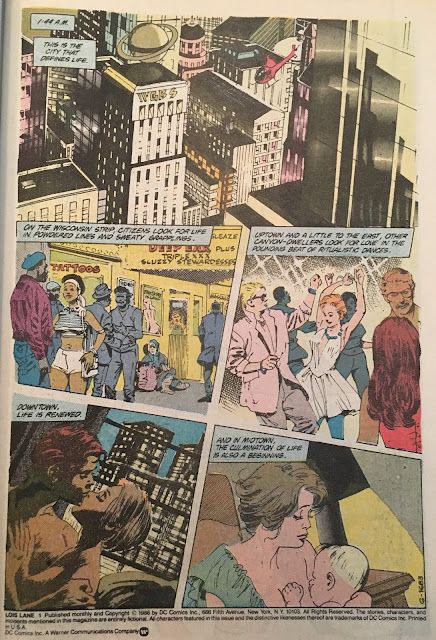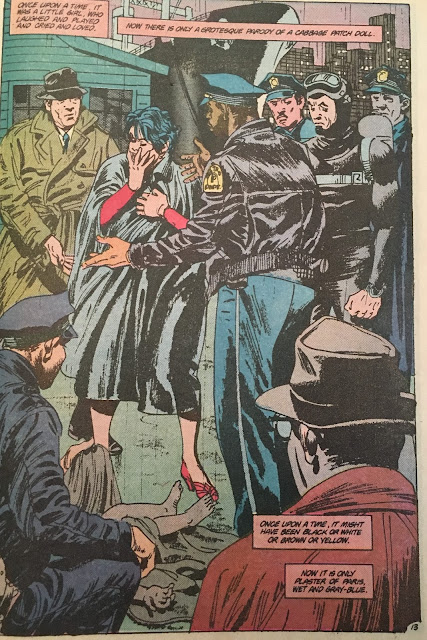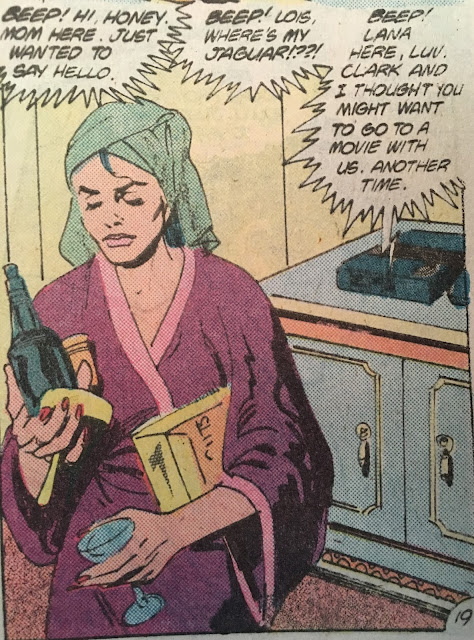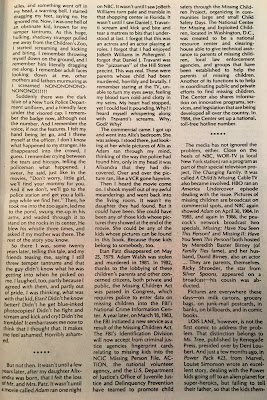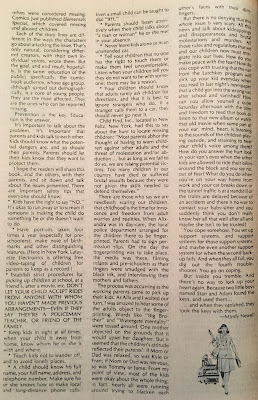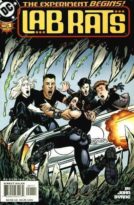Lois Lane #1 (1986)
Lois Lane #1 (August, 1986)
“When it Rains, God is Crying”
Chapter I: “Ignorance Was Bliss”
Chapter II: “Dark Realities”
Writer: Mindy Newell
Artist: Gray Morrow
Letterer: Agustin Mas
Colorist: Joe Orlando
Editor: Robert Greenberger
Cover Price: $1.50
Now I like to think of myself as a guy who’s familiar with comic books. I’ve been collecting forever, and my library features a vast array of oddities. I was actually a bit taken aback finding this comic at a local used record store. I’d never seen or heard of it, and it really stood out in comparison to DC’s other mid-1980’s offerings. There isn’t a whole lot about this two-issue miniseries online, at least to my knowledge, mostly it just shows up in chronology lists. I assume my copy is the Canadian version, as its cover price is $2.10 (which was another thing that stood out to me).
This is a 48-page book, with no ads (barring inside covers). This issue features the first two chapters of “When it Rains, God is Crying”, making me wonder if this was originally planned to be a four-parter.
I’m reading this book at a very strange time. I am a Psychology Major, currently approaching my senior year (yeah, I started the whole higher education thing a decade-plus too late). One of the classes on my docket is Forensic Psychology, which is a class I had been dreading for the past couple of years. It is a very challenging class, and I was worried that I would bomb it hurting my GPA in the process. Long story, well, less long… I am taking the class as I write this, and have found that I have a passion for the course material that I had not anticipated.
This story has to do with missing and abducted children (a fact I was unaware of when I decided to review it), a subject that never really affected me as the wife and I haven’t started having kids yet. For the past two weeks, as part of a cold-case project, I found myself very deeply researching the case of Amber Hagerman, a young girl who was abducted in Arlington, TX in 1996 (and is the “Amber” behind the National AMBER Alert). Her body was found five days later, and tragically, the case remains unsolved to this very day. During the second chapter of this tale, Lois connects with an agency to get information and statistics on missing children. Reading that scene gave me such strange dejavu. She speaks with the director of the agency, and is also there to witness a missing child report being filed by a scared family. These scenes came across as so very real, and considering my academic head-space of late, really affected me.
How does the rest of the story hold up… let’s find out.
—
We open on Lois ending a date with a fellow named Geoff. She observes several police cars speeding off, and considering the late hour she decides to abandon her date (while borrowing his Jag’) and give chase. She follows them down to the pier and sees a group of officers and detectives looking out to the drink. Inspector Henderson attempts to corral Lois into the sanctioned “Press” area, however, she asserts herself and is able to get a better view of what they are pulling out of the water.
Fellow Planet reporter, Bob Harley is unhappy to see Lane both covering his beat and getting special treatment from the Inspector. He calls Editor Ed Byrnes at the Planet and tells him what is going on. Byrnes, in turn, calls acting City Editor James McCullough to pass on the information. McCullough is none to pleased to hear what Lane is up to (and being woken up as well). Byrnes is instructed to “bury” her story. Apparently, Lois is on thin ice from an apparent “botching” of a mid-east interview she conducted, and has been sidelined to reporting “small stuff”.
We cut to a flight attendant attempting to make a phone call from an airport. We find out that she is Lois’ sister Lucy Lane, and she is trying to contact Lois so that they may “bury the hatchet”. She gets Lois’ answering machine, and hangs up without leaving a message. She is headed to Metropolis and wants to give her sister a heads up.
Back at the pier, the body of a young girl is lifted from the water. Upon getting a closer look, Lois is struck with intense emotion, describing the child as “a grotesque parody of a Cabbage Patch doll”. Lois and Henderson retire to his car to collect themselves. Henderson encourages Lois to go home for the evening, even offering to drive her. Lois accepts the ride, however, asks to be dropped off at the Daily Planet so that she may begin her story.
Upon arrival, she is greeted by Byrnes, who informs her that whatever story she is working on, it will not get the front page of the next day’s edition. He offers her one column on page 53 (next to an ad for a Mother’s Day sale on lingerie, no less). Lois begrudgingly accepts, and is sent home shortly thereafter.
Lois returns to her apartment, and checks her answering machine. Among her missed calls is Lana Lang inviting Lois to join her and Clark on their movie date. I’m guessing this puts this story in Pre-Crisis DC continuity. She notes the message (Lucy’s) with the hang-up, and comments that “somebody doesn’t like to talk to a machine”. She also has a message from McCullough demanding an audience with her the next day.
The morning comes, and we witness a discussion between McCullough and Byrnes. Ed informs McCullough that he complied with his demand and buried Lois’ story, though adds that he disagrees with that decision. He reinforces that Lane is an ace reporter, and goes on to say that Lois’ story could be a very good thing for the paper to run with. He left a copy of Lois’ article for McCullough to read.
McCullough reads Lois’ story, and decides to run with it. However, with the caveat that it will be done “his way… or not at all”. He sends for “Metrolife” Features Editor Janice Denton.
Lucy Lane shows up at Lois’ apartment, however, cannot get buzzed in. Lois sleeps through all of the doorman’s attempts at contacting her. Lucy gives up, and decides to try to connect with Lois at the office.
End of Chapter One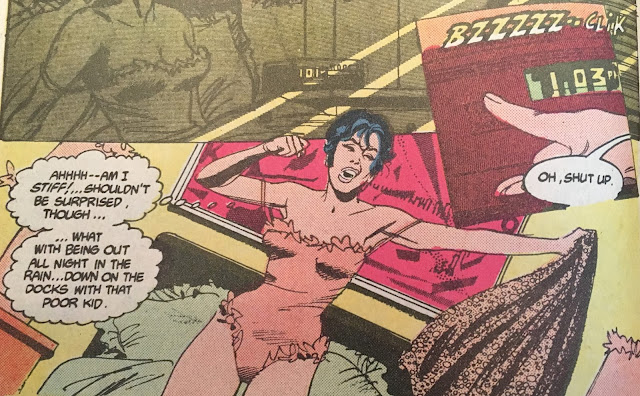 Chapter Two starts with Lois experiencing nightmares about what she had witnessed the night before. She wakes up to find she has overslept, and heads into the office. She attempts to get more information about the case and the victim from Inspector Henderson, but is unsuccessful. She asks if dental records have been checked, even though they have not yet determined a cause of death. Lois is clearly becoming obsessed with this story. Her assistant, Justin provides her with a stack of paperwork he procured from the morgue, things that weren’t yet inputted into the computer system. Their discussion is interrupted by McCullough who lambastes Lois for her tardiness.
Chapter Two starts with Lois experiencing nightmares about what she had witnessed the night before. She wakes up to find she has overslept, and heads into the office. She attempts to get more information about the case and the victim from Inspector Henderson, but is unsuccessful. She asks if dental records have been checked, even though they have not yet determined a cause of death. Lois is clearly becoming obsessed with this story. Her assistant, Justin provides her with a stack of paperwork he procured from the morgue, things that weren’t yet inputted into the computer system. Their discussion is interrupted by McCullough who lambastes Lois for her tardiness.
Meanwhile, at 344 Clinton Avenue Clark Kent and Lana Lang are having breakfast. This is during a time where Clark and Lana are co-anchors for the evening news (so, yeah… Pre-Crisis). Their meal is interrupted by somebody at the door. It is Lucy Lane, seeing if Clark knew Lois’ whereabouts. Clark calls the Planet, and finds that Lois is there, hard at work, and the whole office is gossiping about what she is up to. The three head out to the Planet.
We rejoin Lois and McCullough, now in his office arguing about her story. Lois threatens to quit and take her story to The Eagle, and McCullough informs her that “Metrolife” editor, Janice Denton would be working with her on this story. This infurates Lois, as the Metrolife section is more of a lifestyle supplemental rag concentrating more on “fashion and health notes”. Lois knows her story is “hard news” and belongs at the fore of the paper.
She storms out intending to visit Childsearch, Inc. in New Paltz to try and get more information for her story. I did a bit of digging on Childsearch, Inc., there appears to be several organizations using this name across the United States, however, I was unable to find one in New Paltz, NY. In a written piece, Ms. Newell does make reference to this organization and it’s New Paltz location. The phone number for The National Center for Missing and Exploited Children (1-800-843-5678) is prominently displayed on a poster in the lobby. This is, in fact, still the number for this organization, and on their web-site is where I spent most of this past weekend. It is a wonderful resource, that is an unfortunate necessity. She meets with a Kate Brinkley (could not find her with some brief googling to see if this was she is a real person, though I have little doubt that she is), and is given some statistics. She is told that two million children are reported missing each year, most of which are runaways. They discuss children being abducted by a divorced parent, and those taken by strangers (now referred to as nonfamily abductions).
Personal research tidbit here, I was shocked to find that for nonfamily abductions the first three hours of the abduction are the most critical. Within the first three hours around three-quarters of abducted children are reportedly killed.
Lois and Kate are joined by a family reporting a missing child. In an awesome bit of realism, Newell depicts this family as imploding, blaming each other for the abduction. They are really reaching with the blame, which strikes me as something that would really happen. With something this potentially gruesome, people will say nearly anything to assuage themselves of any guilt.
Brinkley cuts them off quickly, telling them that this is not the time for recriminations, telling them to redirect their hostilities in a positive direction. The character of Kate is written incredibly well. This is the way such a person should be written, she is steady and calm, and does not let the emotion of the moment overtake her. Clearly, Ms. Newell did her research. All the while, Lois is taking notes.
The family shares the story of how their baby daughter went missing. The parents left their young son and baby daughter in the car while they ran into a restaurant to grab some hamburgers. Having something as benign as a burger run be the impetus for an abduction really drives the point home that abductions can occur anywhere, and quickly. A couple of men approached the family car, punched out the young boy, and took the baby girl.
We rejoin Lucy, now walking through a park in Metropolis. She witnesses a child standing with a police officer. The officer blows his whistle and informs the people present that the young boy he is standing with had become separated from his mother. His mother charges up and reclaims the boy, initially seeming thankful… though, she berates the young lad for embarrassing her as they walk away. Seeing this helps Lucy make an association… she thinks she can help Lois with her story.
Lois arrives home only to find Lucy sitting on her couch. Their reunion is quite contentious, and Lois excuses herself to take a bath. Lucy follows her in the bathroom and tells her she thinks she can be of help. Lois scoffs, putting Lucy down. Lucy leaves, Lois is alone in the bath and we are… [to be continued]
—
Whew. That was long, dense, and rather intense.
This was an interesting, mature take on Lois Lane. One that I perhaps was unprepared for. In these 48 pages I feel like I learned so much more about Lois, her drive, her passion, than I have in all my years of reading her in the Superman titles. We see Lois as a person who is defined by her career, and due to the extreme nature of this story, it begins seeping into her “real life”. She is obsessive, determined, and… well, human.
The Lois I’ve always known has been an infallible “Ace” reporter, having this story touch on a story that she “botched” lends to viewing Lois under a new light… one in which her ego had taken a bit of a thrashing, and it not being due to Clark having “scooped” her on a Superman story.
Seeing Clark and Lana together (instead of Lois and Clark) was somewhat heartbreaking. I always had the impression that Lois was okay alone, however, the scenes in her apartment depict a vulnerability, almost a loneliness. It’s like you can see her trying to maintain her “stiff upper-lip”, and in a few scenes here, that façade begins to crack. From the messages on her answering machine, you get the impression that Lois has perhaps alienated herself from her family, and potential suitors.
This is a sad story, no doubt. The sadness seeps into almost every scene. I may be biased here, due to my current research on the subject, but this is one people really ought to read. Not so much for the PSA aspects, all of that information is readily available online (trust me…), but for this novel and mature way of examining the Lois Lane character, her social dynamics, and her place in the world.
Mindy Newell, who I am wholly unfamiliar with did some great work here. In between the chapters there is a three-page written piece by Ms. Newell in which she discusses how she was nearly abducted as a child. Gripping and sobering, this story obviously means a lot to Ms. Newell. The amount of research she did (pre-Internet) and the people she must have spoken to for this story did it such a service. She also refers readers to other contemporary missing child stories going on in comics. Her talent helps steer this issue from becoming a simple PSA that could be set aside with all of our mid-eighties “Just Say No!” comics. This is truly a character piece, and addresses a challenging and sadly real subject.
The art from Gray Morrow is an absolute treat. Clean, identifiable characters with just the right amount of “grit” and realism to truly separate this story from DC’s regular superhero fare. This is an issue predominantly consisting of talking heads, and at no point was it boring to behold.
Read this book. I think we’ll finish up this two-parter tomorrow.
—
No ads here, however here is the back-cover to this issue:
UPDATE 5/7/23 – “Remastered” for WordPress!


